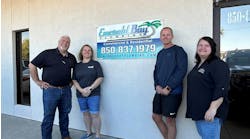Springfield, Mo. — Bass Pro Shops has been expanding. The outdoor retailer has been offering hunting and camping products since 1972, including apparel, footwear, marine equipment and everything an outdoorsman might need for freshwater-, saltwater- and fly-fishing.
The company operates more than 60 stores throughout the U.S. and Canada. Each is typically 150,000-sq.ft., and employs more than 300 people. Over the last four years, P1 Group has helped build more than ten of those stores. So, when the time came to revamp the company's corporate headquarters, Bass Pro was confident P1 had both the experience and the expertise to tackle the job.
P1 Group formed from the merger of two companies, AD Jacobsen — a well-known Kansas City contractor in business since 1919 — and Huxtable & Associates out of Lawrence, Kan., in 1998. A year later, they acquired US Electrical Construction, and in 2001 decided to promote and brand the entire company around the P1 name.
“What P1 stands for,” says Rusty Roderick, director of business development, “is the expertise of many, the power of one.” The goal was to create a one-stop shop, and the work the group provides includes construction, design-build, plumbing, piping, sheet-metal and electrical. They have their own DDC control company and fabrication shops. They do commissioning and sell service contracts, plus much more.
“We try to be all things to all people,” Roderick says.
For the massive overhaul, P1 Group would need to bring its wide array of skills into play. The Bass Pro headquarters was a 1960s era building, still using highly inefficient technology. Also, if the term “corporate headquarters” only makes you think of office suites and conference rooms, think again — the complex is a key distribution hub for the company, measuring more than 1.3 million sq.ft.
“In its day, both the facility and equipment were efficient and made to last,” Dan Hoy, Bass Pro Shops' director of facilities says. “However, it was high time we asked ourselves if we could improve efficiency and reduce expenditures with today's technological gains.”
“They had these inefficient steam boilers from about 1965,” says Roderick. “They would convert the steam to hot water which was then distributed to fan coil units.
“On the cooling side, they had what's called steam-fired, single effect steam absorbers. This is using steam to create chilled water, a very inefficient process.”
After a thorough assessment of the building's needs, including estimation, specification and design, it was time for P1 Group to get in and start changing out the old systems, mainly the old boilers and pumping plant, the chilling equipment and the cooling towers. It all had to go.
First, P1 Group wrecked out the old equipment. Bass Pro donated more than $60,000 worth of scrap to a local charity. Then the contractor installed a hybrid boiler plant consisting of two Unilux boilers and four Patterson-Kelley high-efficiency condensing boilers.
“Sixty percent or 70% of the time you're only at about 50% of the full load,” Roderick explains. “When conditions allow us to operate the high-efficiency boiler, we will. When we're on design days we can bring on the large, standard efficiency units.”
Even the standard units are still an improvement in energy efficiency by nearly 30% more than the old system.
The new boiler plant is controlled by a Johnson Controls DDC building automation system that regulates when the boilers fire. A variable speed pumping system with variable frequency drives enables the operator to vary the flow requirements and achieve even greater energy savings.
A handy by-product of the hybrid system is dual-fuel capability. This goes back to an old agreement Bass Pro had with the local utility.
“When there was a shortage of natural gas,” Roderick says, “Bass Pro would be asked to run on fuel oil. They got a cost break for doing it. With those high-efficiency boilers, that's not a standard part of the package, but the two Unilux boilers will run on both oil and gas.
“Of course, the curtailment should most frequently happen on a design day, when everyone else needs natural gas, and we're running the standard-efficiency boilers anyway. So, we put in a new fuel-oil skid system as well.”
On the cooling side, the headquarters now uses a series of variable-speed, high-efficiency York chillers, and a Veriprime variable primary pumping arrangement. P1 Group also installed all-new cooling towers.
The analysis of the headquarters began in 2005, with the project not awarded until May 2007. The boiler plant came on-line November 2007, and the chiller plant was finished June 2008. Between all trades on-site, Roderick estimates there were between six and eight pipefitters, two to four electricians and a couple of sheet metal workers. Total price of the job came close to $2.9 million.
According to Hoy, since making the change, the greatest single month of energy savings put an extra $64,000 in the company coffers. To date, the average monthly utility savings has been about $40,000.
Now that the heating and cooling plants have been revamped, P1 Group is looking ahead to the next phase of the project: upgrading the old air-handling units.

